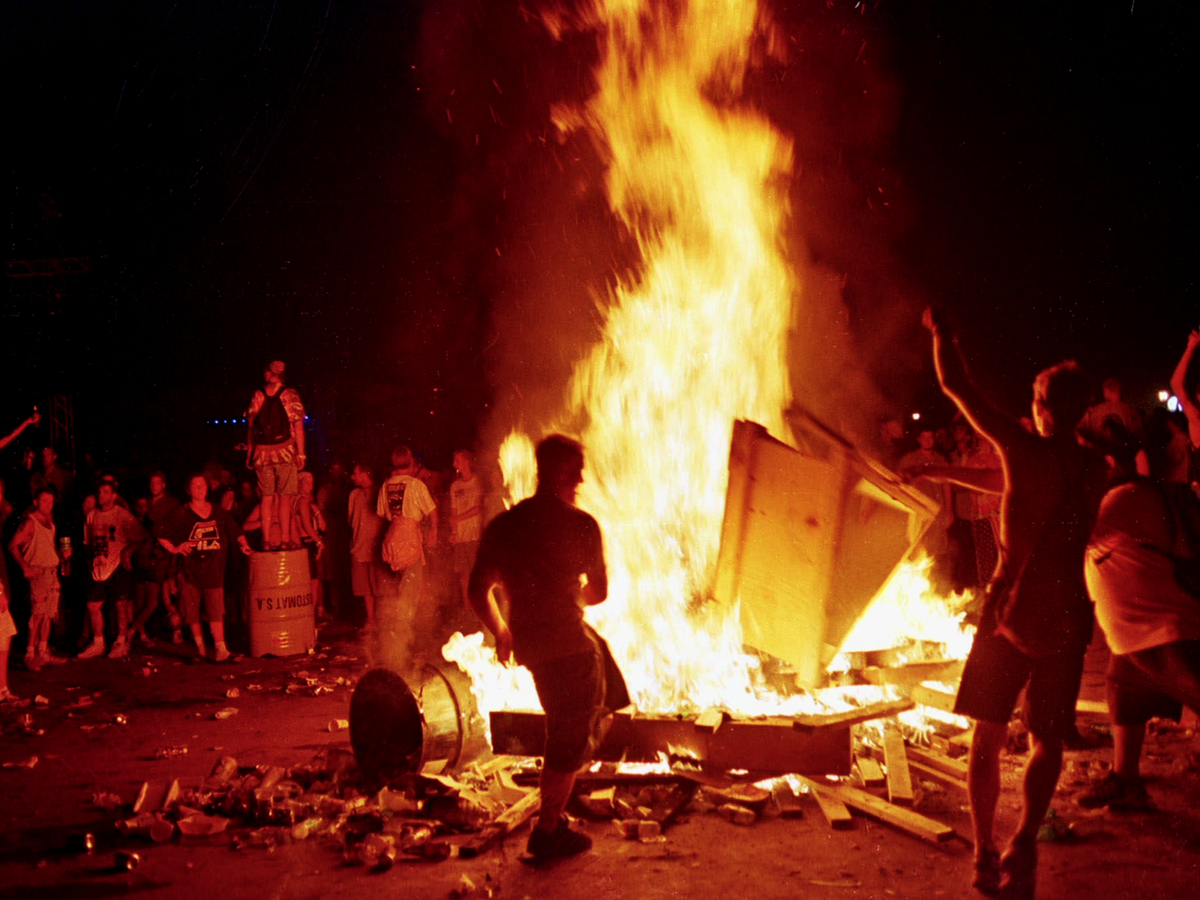
Trigger warning: This article contains reference to violence and sexual assault.
While festivals can be some of the best experiences of a lifetime, Netflix’s new three-part documentary, Trainwreck: Woodstock ’99, shows just how wrong they can go when shockingly poor organisation is combined with nearly half a million people. “If you thought the 6am scene at Glastonbury’s Stone Circle was messy, you ain’t seen nothing yet,” wrote Leonie Cooper in The Independent’s review of the documentary, which depicts the “absolute horror show that was Woodstock ’99”.
Held in Rome, New York, the four-day event was an attempt to replicate the historic harmony of 1969’s “three days of peace, love and music”. In what might be the understatement of the year, 1999’s Woodstock failed. With an estimated 400,000 people on site, temperatures reaching nearly 40 degrees, a lack of available water and a feisty lineup (think Rage Against The Machine, Limp Bizkit, Red Hot Chilli Peppers), things started to get awfully heated. Fires, violence, and sexual assault were all in the picture – and MTV captured it all on camera. From charged crowds of chaos to the promoter’s sheer incompetence, Woodstock 1999 was about as far from peace and love as it physically could have been. Here’s what happened.
The heat
Set on a hard tarmac ex air-force base, Woodstock ’99’s grounds provided little to no shade. High temperatures soon got to the crowd, who had limited access to water. Small bottles were priced at $4 a pop (that would be $7 today), with the company supplier rumoured to be co-owned by the promoter. There were some free water taps, but they were around half a mile from the main stages. They quickly got broken, seeping into a mix of human waste that was overflowing from the limited 2500 toilets that were supposed to serve nearly half a million festival goers. The combination of heat, exhaustion and dehydration left people distressed and subsequently ill; as the overflowing toilets got worse, the human waste cocktail began spilling into the campsite areas, causing upset stomachs and sickness among attendees.
Security (or lack of)
Ahead of the festival, promoters were reportedly in violation of the laws that were put in place to stop a repeat of 1969’s chaos (while the previous edition of the festival was seen as a cultural moment of peace and creativity, it lacked water and sanitation too). However, promoters ducked the threat of cancellation and fines by promising increased security. What happened ended up even worse than ’69; the lack of organisation meant the “peace patrol” weren’t trained properly, with Spin reporting that 100 staff had quit by Friday night. There was a lack of drug searches too, and instead people were rigorously patted down for their own food and drink, which was subsequently taken off them at entry so that they were forced to purchase more when inside. As the festival went on, security staff lessened while attendance grew (the “Peace Wall” was knocked over, meaning people without tickets were able to break in – a grim metaphor for the weekend as a whole).
Sexual assault
Misogyny was rife across the festival, with a herd mentality encouraging dangerous behaviour among some male attendees. Demands of “show your tits” were shouted at female performers such as Sheryl Crow, while Limp Bizkit’s set was said to have had the most violence against women across the weekend. MTV reported two alleged gang rapes in the mosh-pits of headline sets “as concert-goers around the crime cheered her assailants on”. Four rapes were also recorded across the weekend and a police officer working onsite was suspended after he “urged” women to take nude pictures alongside fellow officers. Discussing accounts from the festival, YWCA Rape Crisis director Rosemary Vennero told MTV: “You hear people saying things like, ‘When we went to sleep at night in the tent, I just heard people screaming, and they weren’t screams of pleasure, they were screams of terror.’”
Violence
As festival goers grew angrier and angrier with the conditions, the violence got worse. MTV scrapped recording Limp Bizkit’s set as stones and watermelons were hurled at the tent, and they instead reported from the medical area – described as a mosh triage. Frontman Fred Durst has been criticised for allegedly encouraging the crowds’ animalistic behaviours: he is reported to have said “how many people have ever woken up in the morning and just decided you’re going to break some sh*t?”, before performing their song “Break Stuff”. Spin’s coverage of the festival revealed that the crowd took his sentiments far too literally: “They broke arms, legs, teeth, noses, collarbones. Scalps were lacerated by flying, half-full bottles. One mosher suffered a compression fracture of the spine. Another broke two ribs and prodded the medic treating him to finish quickly so he could return to the pit.” The crowd even gathered wood from the broken fence and catapulted both people and wood in the air as the set continued.
Fire
In what can only be described as a heated finale to the weekend from hell, the enraged crowd, as “dangerous as they were vulnerable”, brought the chaotic festival to a ferocious end. After 100,000 candles for an anti-gun violence vigil were handed out without the knowledge of the fire marshall, they were used to start huge fires in the crowd. Trucks and tankers and even a Mercedes were set ablaze while the Red Hot Chili Peppers covered Jimi Hendrix’s “Fire”. The fires eventually spread to both stages and set an audio tower alight. It’s said that the 12-foot fence surrounding the ex air-force base was broken down further by crowds, not trying to get in, but desperate to get out.







